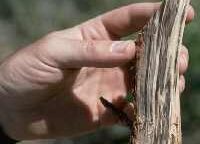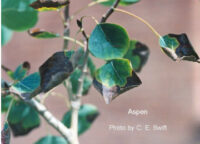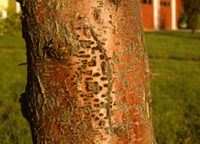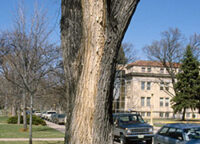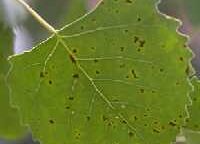- 07, 10, 2015
- No Comments.
- By
Pinyon Pine Diseases and Insects – 2.948
Print this fact sheet by W.R. Jacobi and W.S. Cranshaw * (12/14) Quick Facts… Pinyon pines are well-suited to many parts of Colorado. These pines make good visual screens, windbreaks, and wildlife habitat. Major diseases include black stain root disease, dwarf mistletoe, armillaria root disease, and pinyon decline. Common insect pests are pinyon pitch mass […]
Take a Tour- 07, 10, 2015
- No Comments.
- By
Pine Wilt Disease – 2.915
Print this fact sheet by D. Atkins, T.S. Davis and J.E. Stewart* (5/20) Quick Facts… Pine wilt is a lethal disease caused by a native nematode (Bursaphelenchus xylophilus), vectored to trees by a wood borer insect–the pine sawyer beetle (Monochamus spp.). Exotic pines including Scots, Austrian, and mugo are susceptible to infection by the nematode. Some […]
Take a Tour- 07, 09, 2015
- No Comments.
- By admin
Mistletoes in Colorado Conifers – 2.925
Print this fact sheet by R.D. Koski, W.R. Jacobi and C.E. Swift * (12/13) Quick Facts… Mistletoes are parasitic flowering plants that can infect and damage many tree species. Dwarf mistletoes (Arceuthobium spp.) are leafless parasitic plants that infect several coniferous or evergreen tree species in many western states. Ponderosa, lodgepole, limber, and pinyon pines […]
Take a Tour- 07, 09, 2015
- No Comments.
- By admin
Leaf Scorch – 2.911
Print this fact sheet by S. Rose and C.E. Swift * (12/14) Revised by L. Langelo** Quick Facts… Leaf scorch can appear as leaf spots or a burn along the margin of the leaf. Improper watering is the common cause of leaf scorch. Too much fertilizer can cause leaf spots and marginal burning. Scorched tree […]
Take a Tour- 07, 09, 2015
- No Comments.
- By
Honeylocust Diseases – 2.939
Print this fact sheet by W.R. Jacobi* (12/13) Quick Facts… Cankers and root collar rot are the major diseases of honeylocusts because they can girdle the stem and kill the tree. Canker disease symptoms include sunken, dead areas of bark; dieback; reduced foliage; yellow foliage; premature fall coloration; and early leaf drop. To control canker […]
Take a Tour- 07, 09, 2015
- No Comments.
- By
Environmental Disorders of Woody Plants – 2.932
Print this fact sheet by C.E. Swift, W.R. Jacobi, M. Schomaker and D.A. Leatherman * (8/20) Revised by E. Hammond** Quick Facts… Sunscald occurs during cold, bright days in midwinter. It occurs more frequently on thin-barked trees. Wrap trees in winter to help prevent sunscald. Drought and overwatering injuries occur in deciduous and evergreen trees. […]
Take a Tour- 07, 08, 2015
- No Comments.
- By admin
Cytospora Canker – 2.937
Print this fact sheet by W.R. Jacobi* (12/13) Quick Facts… Figure 1: Orange discoloration found in spring and early summer associated with cytospora canker. Figure 2: Cytospora canker on three branches, each with scattered pycnidia. Figure 3: Orange spores oozing from pycnidia. Cytospora canker is caused by several species of Cytospora (sexual form Valsa and […]
Take a Tour- 07, 08, 2015
- No Comments.
- By
Bacterial Wetwood – 2.910
Print this fact sheet by W.R. Jacobi* (12/13) Quick Facts… Figure 1. Discoloration of bark of American elm affected with wetwood. (W.R. Jacobi). Figure 2. Wetwood discoloration at branch crotch on American elm. (W.R. Jacobi). Bacterial wetwood is a common disease that affects the central core or bark of many shade and forest trees. Slime […]
Take a Tour- 07, 08, 2015
- No Comments.
- By
Aspen and Poplar Leaf Spots – 2.920
Print this fact sheet by W.R. Jacobi * (12/13) Quick Facts… Five fungi cause most foliage diseases on aspen, cottonwoods and other poplar species. Foliage diseases develop readily in wet, cool weather. Foliage diseases decrease a tree’s aesthetic value and can cause premature defoliation. Severe outbreaks can affect tree growth and reduce defense capabilities of […]
Take a Tour- 07, 07, 2015
- No Comments.
- By
Xeriscaping: Retrofit Your Yard – 7.234
Print this fact sheet by C.R. Wilson and A. Cummins* (10/20)Revised by J. Murgel** Quick Facts… As much as 50 percent of household water is used for the yard and garden. Change turf areas on steep slopes, hard-to water places and narrow mowing strips to low water ground covers. Use or update an irrigation controller […]
Take a Tour
